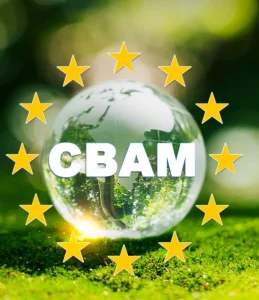The Carbon Border Adjustment Mechanism (CBAM) mandates cooperation between the European Union and the Climate Protection Authority of each member state. This obligation takes effect on January 31, 2024, for the initial round of data provision. Starting in 2026, it will encompass both data provision and payment requirements.
Ekotox Centers are providing consultancy services and customers support in the area of EU CBAM reporting
If you need assistance, please contact us at one of the following contacts:
- e-mail on ekotox(at)ekotox.eu
- Ekotox Centers: Overview | LinkedIn
What is the CBAM
Enacted in October 2023 as part of the EU’s Fit for 55 package, the CBAM complements the EU Emissions Trading System (EU ETS). It imposes a price on certain greenhouse gases (GHGs) emitted in the production of selected imports, aligning with EU GHG reduction goals, preventing carbon leakage, and leveling the playing field for EU and non-EU producers. Carbon leakage is the relocation of industry due to differences in carbon pricing between jurisdictions.
Currently, CBAM covers imports of cement, iron and steel, aluminum, fertilizers, electricity, and hydrogen. The EU plans to assess and possibly expand CBAM coverage by 2030, aiming to include over half of emissions in EU ETS sectors by 2034.
CBAM reports quarterly
| Quarter | Submission due by | Modification possible until |
| 2023: October – December | 2024: 31/01/ | 2024: 31/07/ |
| 2024: January – March | 2024: 30/04/ | 2024: 31/07/ |
| 2024: April – June | 2024: 31/07/ | 2024: 30/08/ |
| 2024: July – September | 2024: 31/10/ | 2024: 30/11/ |
| 2024: October – December | 2025: 31/01/ | 2025: 28/02/ |
| 2025: January – March | 2025: 30/04/ | 2025: 31/05/ |
| 2025: April – June | 2025: 31/07/ | 2025: 31/08/ |
| 2025: July – September | 2025: 31/10/ | 2025: 30/11/ |
| 2025: October – December | 2026: 31/01/ | 2026: 28/02/ |
For now, CBAM importers have reporting obligations, with the first quarterly reports due on 31 January 2024. Due to filing difficulties, companies can request a 30-day extension. Starting 1 January 2026, Authorised CBAM Declarants must submit annual reports and purchase CBAM certificates, with financial obligations beginning. The price of these certificates will match the average price of EU ETS allowances, equalizing carbon pricing costs between the EU and non-EU producers.
CBAM: Legal background and who is responsible
In May 2023, the European Union Decree (2023/959 of the European Parliament and Council: https://eur-lex.europa.eu/legal-content/EN/TXT/PDF/?uri=CELEX:32023R0956) included rules and measures to offset the carbon intensity of imported goods.
The aim of the measure is to offset the competitive advantage of products produced in a cheaper but more environmentally polluting way in EU countries and to reduce emissions.
Companies (mainly producers and traders of energy, fertilizer and chemicals, players in the automotive and machinery industry, as well as traders of iron, steel and aluminum raw materials) who import products belonging to the CBAM are subject to a reporting obligation, and later also a payment obligation.
CBAM data submission obligation: tasks
- Create an EU login account, which can be created by anyone as a natural person
- Registration with the appropriate National Climate Protection Authority
Having an EU account ID, you must initiate temporary registration with the National Climate Protection Authority
- After successful registration, you will be able to enter the CBAM interface managed by the EU, where you can make the specific quarterly report.
CBAM data service challenges and difficulties
If a CBAM-obligated company has fulfilled the first points so far, it has actually fulfilled its CBAM registration obligation, but the challenges are not over yet.
- Difficult to use English-language CBAM interface
When reaching the CBAM interface managed by the EU, farmers are faced with the fact that the page is only available in English, complex and difficult to use. If not already, then it is certain that the companies affected by the CBAM obligation will need help here – among other things, because the necessary data can be determined from the customs clearance documents.
- It does matter in whose name the CBAM declaration is made
CBAM data provision is significantly influenced by the fact that the declaration is made in the importer’s own name, or as a customs representative in the name of the importer or the represented importer. In addition, many people try to act in the interests of their clients as a simple representative, which is currently not feasible.
3. The range of goods covered by the CBAM obligation is expanding
In the future, it can be expected that the range of affected goods will expand, as well as data that will require the cooperation of the exporting partner.